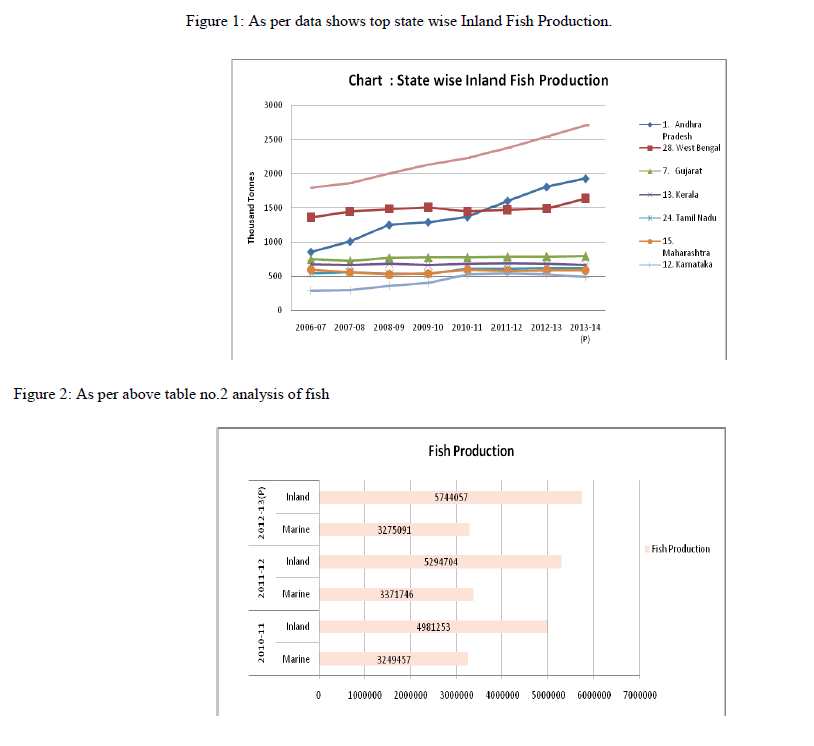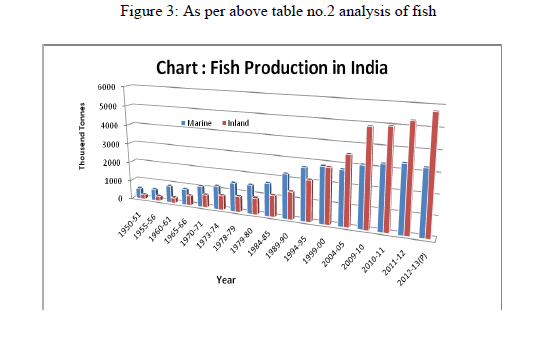Keywords
|
| Inland Fishing, Marine Fishing, Grown rate, Comparative Analysis etc. |
INTRODUCTION
|
| The country has a long coastline of 8118 km and equally large areas under estuaries, backwaters, lagoons etc., conducive for developing capture as well as culture fisheries. With the declaration of the Exclusive Economic Zone (EEZ) in 1977, an area of 2.02 million sq km, (comprising of 0.86 million sq. km on the west coast, 0.56 million sq.km on the east coast and 0.60 sq.km around the Andaman & Nicobar Islands) has come under our jurisdiction with absolute right of exploring, exploiting and natural utilization of living resources falling within it. The inland fishery resources include 1.96 lakh kms stretch of rivers and canals, 29.07 lakh hectare reservoirs, 24.40 lakh hectare ponds and tanks, 7.98 lakh hectare of beels, derelict water bodies and 12.40 lakh hectare brackish water areas (Handbook on Fisheries Statistics, 2014). |
| Fishery Science and Agriculture is the sunshine sector of Indian Economy which provide livelihood to the economically backward population. Moreover, Fishery Science has immense scope and potential to earn foreign currency. It has been recognized as a powerful income and employment generator as it stimulates growth of a number of subsidiary industries and is a source of cheap and nutritious food besides being a source of foreign exchange earner. |
METHODS AND DATA
|
| 1. Data Sources: For this study secondary data were used. Relevant secondary data were collected from FAO database, MPEDA publication and various research bulletins. 2. Data Type: Secondary Data Collected from various annual reports, research papers and conferences published time by time by Department of Animal Husbandry Dairying & Fisheries (DADF). 3. Data Analysis: Statistical methods are used for data Analysis, where different graphs (Line Graph, Bar Graph & Column Graph ) are used to explain actual statistical tables in simple form. |
RESULTS
|
| 1. In Inland Fish Production Andhra Pradesh is showing aggressive growth pattern from 2006 till 2014 amongest all states. In first 3 years though West Bengal was the top producing state; but now it holds second position and shows a steady growth. Other top producing states are Gujrat, Kerela, Tamilnadu, Maharashtra, Karnataka indicating flat growth (Figure 1). |
| 2. Marine fish production was lower than inland fish production till 1995. In 2000 Marine and Inland fish production was almost equal. And then marine production crosses inland fish production from 2005 till date showing accelerated growth. Tough fish production is increasing in both Inlad and marine resources, but hike is more in marine production; instead inland fish production loses its tempo from 2005 till date. (Figure 2). 3. If we consider fish production in last 3 years (2011 to 2013) the growth in marine production is flat; Inland fish production is also not very much inspiring. (Figure 3) |
| 4. Graphs |
 |
 |
DISCUSSION
|
| Though last 3 years growth is not inspiring , but inlad fish production can increased by optimize the use of resources. The total fish production during 2013-14(P) is at 9.58 million metric tonnes with a contribution of 6.14 million metric tonnes from inland sector and 3.44 million metric tones from marine sector respectively. The overall growth in fish production in 2013-14 has been 5.9%, which has been mainly due to 7.3% growth in inland fish production. The growth in marine fish production has been 3.7% (Handbook on Fisheries Statistics, 2014). |
CONCLUSION
|
| India as a whole has diverse ecological and climatic conditions, case studies on various fish production systems help identifying suitable culture practice for selected environmental conditions (Mandal et.al., 2007). Although it is blessed with favourable geographic and climatic conditions needed for developing fishery, but yet modern methods of enterprise development is necessary. By undertaking a systematic empirical process on the dynamics of fisheries development limitations can be overcome and growth can be enhanced. Assam or North East India also can play a major role in fish production through introduction of modern technology. |
ACKNOWLEDGEMENTS
|
| We want to offer special thanks to Mr. Amol Nale (Young Enterprenour) for sharing with us his ideas & business knowledge. Also we are grateful to all other supportive people we get on the way for providing us knowledge and information. |
References
|
- Alipio BC, David FC, Isabel RS, Juan CNM. Manuel AE. Comparison of batch, stirred flow chamber, and column experiments to study adsorption, Desorption and transport of carbofuran within two acidic soils. Chemosphere. 2012; 88(1): 106-120.
- Arnaud B, Richard C, Michel S. A comparison of five pesticides adsorption and Desorption processes in thirteen contrasting field soils. Chemosphere. 2005; 61(5): 668-676.
- Chunxian W, Jin-Jun W, Su-Zhi Z, Zhong-Ming Z. Adsorption and Desorption of Methiopyrsulfuron in Soils. Pedosphere. 2011; 21(3): 380-388.
- Chunxian W, Suzhi Z, Guo N, Zhongming Z, Jinjun W. Adsorption and Desorption of herbicide monosulfuron-ester in Chinese soils. J Environ Sci. 2011; 23(9): 1524-1532.
- Christine MFB, Josette MF. Adsorption-desorption and leaching of phenylurea herbicides on soils. Talanta. 1996; 43(10): 1793-1802.
|